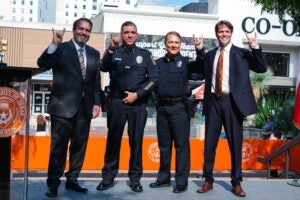AUSTIN, TexasJack Kilby, the Nobel Prize-winning engineer whose demonstration of the first microchip in 1958 revolutionized the electronics industry, spoke on Sept. 9 about the events surrounding his historic breakthrough.
Fittingly, his lecture took place in the Applied Computational and Engineering and Sciences (ACES) Building, a showcase for the kind of cutting-edge microelectronics technology his invention helped make possible.
|
|
||
|
Nobel Laureate and co-inventor of the integrated chip, Dr. Jack Kilby, on his visit to The University of Texas at Austin. |
Raised in Kansas, where his father owned an electric company, Kilby grew up interested in power transmission and telecommunications. He earned his bachelor’s degree in electrical engineering from the University of Illinois in 1947. It was an exciting time for engineers, he recalledthe tail end of the age of vacuum tube-based electronics. In 1948, Bell Laboratories introduced the first transistor, destined to replace the heavy, fragile tubes that gobbled power, took up space and produced unacceptable amounts of heat. The new technology captured his imagination.
“I knew I wanted to be part of that,” he said.
His first job, with Centralab in Milwaukee, Wis., was developing circuits for hearing aids, radio and TV. During 11 years there, he learned the trade thoroughly, while racking up a dozen patents.
By the 1950s, Bell was licensing its transistor technology, and the U.S. military was a major customer for transistor-based products. Deciding his future lay with a large semiconductor manufacturer, Kilby applied to several Texas firms.
At Texas Instruments in Dallas, a recruiter named Willis Adcocktoday a University of Texas at Austin professor emeritus of electrical and computer engineeringoffered him a full-time position, starting in May 1958.
Once hired, Kilby quickly went about addressing the fledgling industry’s main challenges: high cost, a complicated assembly process, the desire for ever-smaller components. His solution was to design and build an “integrated” electric circuit with all its components fabricated from a single piece of semiconductor material. The device: a tiny phase shift oscillator, comprising a lone transistor and a few other components on a slice of germanium less than half the area of a paper clip in size. On Sept. 12, he successfully tested his simple prototype in the presence of a handful of Texas Instruments colleagues.
Surprisingly, the technology community didn’t rush to embrace the groundbreaking innovation. It wasn’t cost-effective, they grumbled. It didn’t exploit the materials fully. And it would put circuit designers out of work.
In the end, the militaryprime mover behind much semiconductor industry researchtook the lead.
|
|
||
|
Dean Ben Streetman shares a story with (left to right) National Instruments CEO Jim Truchard, Professor Ted Rappaport and Nobel Laureate Jack Kilby. |
“The turning point came with the applications to the Apollo moon mission and the Minuteman missile during the 1960s,” he said. “By the late 1960s, most engineers had accepted that integrated circuits were here to stay.”
Kilby was quick to credit other pioneering researchers, both early and later, whose contributions to chemistry and lithography helped bring modern microelectronics into being. Today’s silicon-based chips hold hundreds of thousands of individual components, in contrast to the 10,000 or so of the 1970s and the few dozen of the earliest commercial models. He thinks that trend will continue well into the future, bringing vast quality of life improvements in areas like telecommunications.
“I believe the best is yet to come,” he said.
The imposing, 6’7″ Kilby spiked his talk with humor, at one point invoking the words of a beaver to a rabbit in front of Hoover Dam. “No, I didn’t build it myself,” the beaver tells his companion. “But it’s based on an idea of mine.”
In closing, he projected the image of the microchip that started it alla blob of geranium on a glass slide, with a handful of components and wires sticking out every which way.
“If I’d known I’d still be looking at this 50 years later, I’d have made it prettier!” he quipped.
Kilby received the 2000 Nobel Prize in physics for his part in the invention of the integrated circuit. His previous honors include the National Medal of Science (1970) and induction into the National Academy of Engineering (1974) and the National Inventors’ Hall of Fame (1982). The co-inventor of the hand-held calculator, he holds more than 60 U.S. patents.
His talk kicked off the Electrical and Computer Engineering Department’s year-long ECEntury Distinguished Lecture Series commemorating the department’s 100th anniversary.
Photos: Charles Tischler
For more information contact: Becky Rische, College of Engineering, 512-471-7272.





